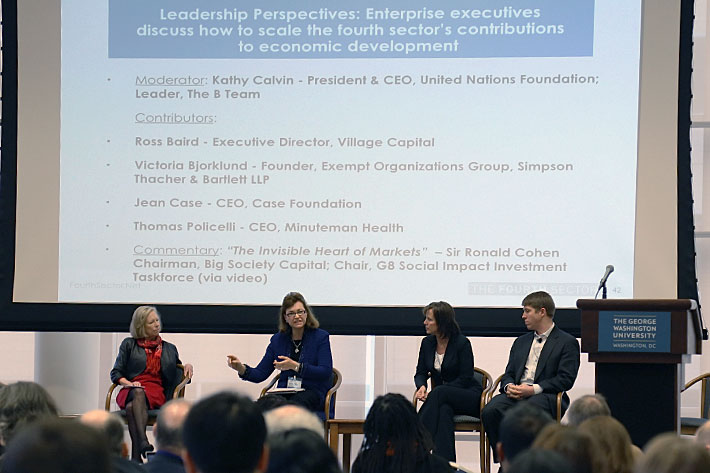Traditionally defined, the public, business and nonprofit sectors have separate—and even competing—interests.
But a wave of for-benefit enterprises seeking profit and social good are blurring boundaries and building a “fourth sector,” according to Joseph Cordes, associate director of the George Washington University Trachtenberg School of Public Policy and Public Administration.
“The fourth sector—what many people call for-benefit organizations— is emerging, and the organizations in that sector strive to contribute to economic growth and address social and environmental problems,” Dr. Cordes said.
George Washington President Steven Knapp gave welcoming remarks to Dr. Cordes and 200 experts, policymakers, government officials, investors and scholars who gathered Thursday at the George Washington University to explore the boundaries and opportunities of the emerging fourth sector.
The conference, centered on the Mapping the Fourth Sector initiative, was cohosted by TSPPPA, the Richard Branson-led B Team organization, the Federal Reserve Board Division of Consumer and Community Affairs and the Urban Institute Center on Nonprofits and Philanthropy.
Participants were largely concerned with defining the fourth sector in relation to existing nonprofit, business and public entities. For example, Minuteman Health— a nonprofit organization that provides membership-based health insurance to individuals and small businesses— and Big Society Capital— a financial services firm for nonprofit and social enterprises—are both considered members of the fourth sector.
The initiative was launched by the Urban Institute and funded in 2013 through the Impact Economy competition held at Harvard University. The B Team is partnering on the project to collect data globally on the developing fourth sector.
The event began with one question: What are the benefits of fourth sector enterprises?
Rajiv Joshi, managing director of the B Team, said that fourth sector organizations have the potential to solve critical world issues from income inequality to global warming.
“We need to shift the purpose of business so that the purpose of business is not just to maximize quarterly returns but to drive social, environmental and economic benefit,” Mr. Joshi said. “The businesses that are taking the lead on that agenda are thriving.”
Jean Case, CEO of the Case Foundation, encouraged attendees to “unleash” themselves and consider fourth sector organizations as a “new way to solve old problems.”
“What’s important to remember is that this world is disruptive,” Ms. Case said. “No matter what sector you’re in, no matter what business, nonprofit or what you do, your world is disrupted, so in some ways it’s a beautiful time to bring some order, some organization and some structure… to this space that we are calling the fourth sector.”
Participants transitioned from panel discussions to working group sessions and forged connections to tackle issues such as defining for-benefit organizations, supporting one another financially and developing partnerships for collaboration.
Dr. Knapp said that GW students are already adapted to the practice of blending the ideals of sustainability with for profit business ventures.
“Many of our students are actively dreaming about and creating their own fourth sector business,” Dr. Knapp said. “Their commitment to the future of the fourth sector is often what inspires us—as faculty and administrators—to cross the boundaries of academia and government and for-profit and nonprofit organizations.”


